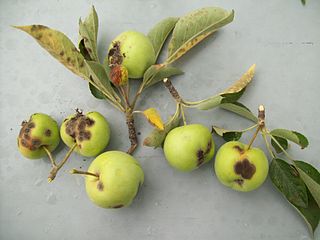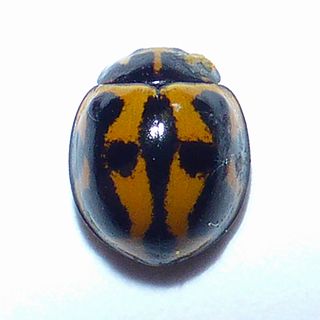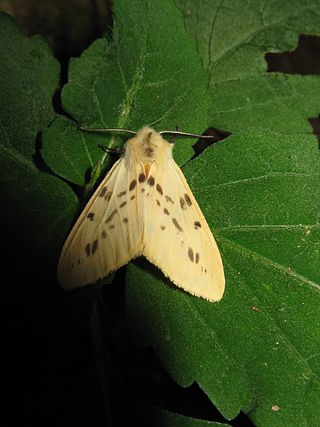
Apple scab is a common disease of plants in the rose family (Rosaceae) that is caused by the ascomycete fungus Venturia inaequalis. While this disease affects several plant genera, including Sorbus, Cotoneaster, and Pyrus, it is most commonly associated with the infection of Malus trees, including species of flowering crabapple, as well as cultivated apple. The first symptoms of this disease are found in the foliage, blossoms, and developing fruits of affected trees, which develop dark, irregularly-shaped lesions upon infection. Although apple scab rarely kills its host, infection typically leads to fruit deformation and premature leaf and fruit drop, which enhance the susceptibility of the host plant to abiotic stress and secondary infection. The reduction of fruit quality and yield may result in crop losses of up to 70%, posing a significant threat to the profitability of apple producers. To reduce scab-related yield losses, growers often combine preventive practices, including sanitation and resistance breeding, with reactive measures, such as targeted fungicide or biocontrol treatments, to prevent the incidence and spread of apple scab in their crops.

Venturia inaequalis is an ascomycete fungus that causes the apple scab disease.

Coelophora inaequalis, the variable ladybird, common Australian lady beetle or common Australian ladybug is a ladybird species endemic to Australia, Oceania and Southern Asia. The variable ladybird gets its name from the black markings on the adult elytra, that vary from one individual to another.
Trachelostenus is a genus of darkling beetles in the family Tenebrionidae. It is native to the Valdivian forests of Chile, and has at least two species, T. inaequalis (Solier) and T. fascicularis (Philipp). It was historically considered the only member of the family Trachelostenidae, but a 2015 study sunk the genus into the tenebrionid subfamily Tenebrioninae.

Acalolepta australis is a species of flat-faced longhorn beetle belonging to the family Cerambycidae, subfamily Lamiinae.

Acalolepta is a genus of flat-faced longhorns beetle belonging to the family Cerambycidae, subfamily Lamiinae. Its members are found in the Indomalayan realm.

Lemyra inaequalis is a moth of the family Erebidae first described by Arthur Gardiner Butler in 1879. It is found in Japan and Korea.
Copelatus inaequalis is a species of diving beetle. It is part of the genus Copelatus of the subfamily Copelatinae in the family Dytiscidae. It was described by Sharp in 1882.
Acalolepta griseofasciata is a species of beetle in the family Cerambycidae. It was described by Stephan von Breuning in 1935, originally under the genus Dihammus. It is known from Papua New Guinea, Vanuatu, and the Solomon Islands.
Acalolepta magnetica is a species of beetle in the family Cerambycidae. It was described by Francis Polkinghorne Pascoe in 1866, originally under the genus Monochamus. It is known from Micronesia, Moluccas and Indonesia.
Acalolepta permutans is a species of beetle in the family Cerambycidae. It was described by Francis Polkinghorne Pascoe in 1857, originally under the genus Monohammus. It is known from Japan, Vietnam, Taiwan, and China. It feeds on Albizia julibrissin.
Acalolepta montana is a species of beetle in the family Cerambycidae. It was described by Per Olof Christopher Aurivillius in 1916. It is known from Sulawesi.
Acalolepta flocculata is a species of beetle in the family Cerambycidae. It was described by Gressitt in 1935. It is known from Taiwan and China.

Acalolepta fraudatrix is a species of beetle in the family Cerambycidae. It was described by Henry Walter Bates in 1873. It is known from Korea, Japan, China, and Russia.
Acalolepta mixta is a species of beetle in the family Cerambycidae. It was described by Frederick William Hope in 1841, originally under the genus Monohammus. It is known from Australia, and was introduced to the Solomon Islands, Indonesia, Singapore and Vietnam. It feeds on Theobroma cacao, Adansonia digitata, Mangifera indica, Excoecaria agallocha, and Moringa oleifera.
Acalolepta rusticatrix is a species of beetle in the family Cerambycidae. It was described by Johan Christian Fabricius in 1801, originally under the genus Lamia. It is known from Myanmar, India, the Philippines, Malaysia, Sumatra, Sri Lanka, Java, Taiwan, Indonesia, Sulawesi, and Vietnam.
Acalolepta sejuncta is a species of beetle in the family Cerambycidae. It was described by Henry Walter Bates in 1873. It is known from Japan.
Pomatodelphis is an extinct genus of river dolphin from Middle Miocene marine deposits in Alabama, Florida, Brazil, Germany and France.
Curvularia inaequalis is a plant saprobe that resides in temperate and subtropical environments. It is commonly found in the soils of forage grasses and grains. The species has been observed in a broad distribution of countries including Turkey, France, Canada, The United States, Japan and India. This species is dematiaceous and a hyphomycete.





